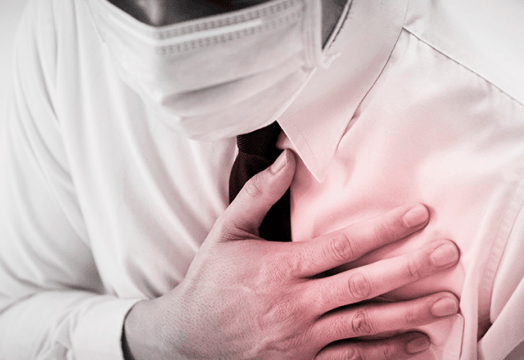Several United States societies (the American Heart Association [AHA] among them) have answered the question of many physicians in the front lines: what is the ideal strategy for the treatment of ST segment elevation myocardial infarction (STEMI) during the COVID-19 pandemic?

This document intends to ensure that patients with STEMI continue to receive adequate, proven life-saving treatment, while minimizing the risk of exposure to the infection for both patients and healthcare personnel.
In normal conditions, systems of care were constantly audited to reduce the time to the reperfusion strategy. The pandemic has changed both schedule compliance and time registration and auditing.
Delays are to be expected across all stages of infarction care, from the patient’s decision to consult with a physician about their symptoms until a Thrombolysis In Myocardial Infarction [TIMI] III flow is achieved.
Read also: Management of Infarction During the COVID-19 Pandemic.
Hospitals all over the world are reporting substantial declines in patient consults to emergency services for STEMI-like symptoms. Fear of contagion is surely playing a significant role in the population.
Alert the population so that they communicate with emergency services
Authorities seem to be completely dedicated to the COVID-19 pandemic. Consequently, cardiologists must assume the responsibility of advising the population to immediately call emergency services in case of signs and symptoms of acute coronary syndrome (this also applies to stroke). Patients must also feel confident that all safety measures will be taken.
Emergency services and pre-hospital care
As a part of how emergency services usually triage callers, asking about patient symptoms (in this case, STEMI symptoms), responders should also ask a series of questions to assess the presence of COVID-19 signs in both the patient and other family members. This information will be useful at the time of going into the patient’s home. In any case, responders should don the appropriate personal protective equipment as if the patient were infected with COVID-19.
A 12-lead electrocardiogram should be expedited and interpreted as soon as possible, and findings (and likelihood of COVID-19 infection) should be communicated to the Emergency Department that will receive the patient.
If a STEMI diagnosis is clear, pre-hospital Catheterization Lab activation should occur immediately, to speed up the process. However, this seems unlikely in this time and age, particularly if we take into account that a COVID-19 infection can mimic almost all cardiac signs and symptoms.
Emergency Department
In case of patients presenting in the Emergency Department on their own, they must be triaged to assess their risk of infection and determine their placement in the right area (COVID positive or suspect and COVID negative areas).
Testing for COVID-19 should not delay primary angioplasty for those with clear STEMI. In unclear patients, transthoracic echocardiography may be helpful to confirm left ventricular wall motion abnormality. If the patient requires or might require mechanical ventilation, a lower than usual threshold is preferred, and the patient should be intubated before transport to the Catheterization Lab.
Patients with clear STEMI who cannot undergo primary angioplasty within 120 minutes should receive fibrinolytic therapy.
For as long as there is no healthcare system breakdown, primary angioplasty should remain the reperfusion strategy of choice, since it is the best option to achieve TIMI III flow and it has lower rates of reinfarction, stroke, and mortality. In these pandemic times, we should count with the advantage of a clear diagnosis for patients who might be infected and experience symptoms that mimic a STEMI.
Catheterization Lab
Cath lab personnel should be familiarized with personal protective equipment, so that they can don it and take it off safely and quickly (this is the step with the highest risk of contamination).
If possible, there should be one lab assigned to COVID-19 positive patients, stocked with the essentials for the treatment of STEMI. Negative pressure within the room is ideal (but seldom available); cleaning personnel should wait an hour for the precipitation of aerosol respiratory secretions, and the room should ideally remain unused for the next 4 to 6 hours. Since 25-50% of patients infected with COVID-19 are asymptomatic, personnel should assume all patients are COVID-19 positive.
Post-reperfusion hospital care
Triaging patients to proper (COVID-19 positive or negative) units after angioplasty is crucial.
Uncomplicated cases can remain in intermediate care areas, so as to preserve critical care beds for patients whose life depends on such care. Patients should receive the usual standard of care, including medical therapy and assessment of left ventricular function. If hospital beds are in extreme demand, early discharge between 24-48 hours after angioplasty may be considered in uncomplicated cases.
Home-based care
Guideline recommendations should still be followed during the pandemic. An effort should be made to implement telemedicine, so that in-person visits are as few as possible. Telemedicine may offer the advantage of providing access to family members who may have been prohibited from entering the hospital during hospitalization and being briefed.
Cardiac rehabilitation
Staying at home will inevitably impact rehabilitation opportunities. However, it should remain “in the agenda” as pending, so that it can be addressed after the pandemic peak.
circulation-aha-120-048180Original Title: Temporary Emergency Guidance to STEMI Systems of Care During the COVID-19 Pandemic: AHA’s Mission: Lifeline.
Reference: Alice K. Jacobs et al. 10.1161/CIRCULATIONAHA.120.048180.
Get the latest scientific articles on interventional cardiologySubscribe to our weekly newsletter
We are interested in your opinion. Please, leave your comments, thoughts, questions, etc., below. They will be most welcome.





